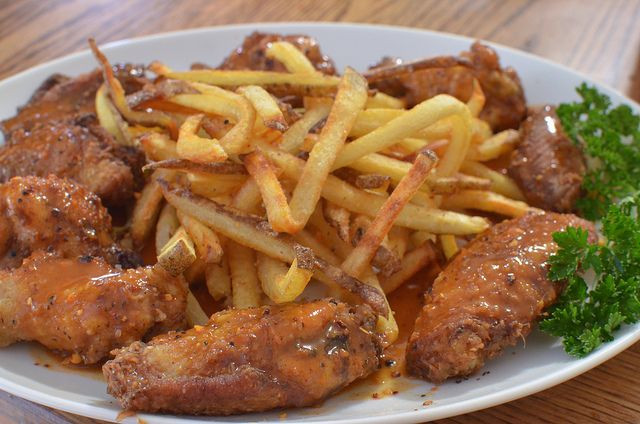Chicken Wings And Fries: Words Associated With High-Calorie Foods Could Spur Obese People To Eat More

When it comes to how fat or how skinny we are, there are a lot of determining factors. A pair of new studies have shown that “food cues” — internal or external environmental factors that influence the desire to eat — may also have an effect on our waistline.
Researchers led by Dr. Susan Carnell, a member of The Obesity Society (TOS) and assistant professor of psychiatry and behavioral sciences at Johns Hopkins University School of Medicine, presented their findings at The Obesity Society Annual Meeting at ObesityWeek 2015 in Los Angeles. Their studies reinforce the idea we need to better understand how external food environments interact with our bodies, and may also help develop behavioral interventions for people with obesity or those who are at high risk of the disease.
The studies looked at food cues, which appear in different forms like emotions, smells, tastes, images, and even words. It was food words, however, that most interested researchers, as they found they're less subtle than smells or tastes but are much more ubiquitous, appearing everywhere in advertising and other contexts, which can increase their impact on how we eat.
In the first study, 17 participants with obesity and 12 participants of normal weight underwent a functional magnetic resonance imaging (fMRI) scan while they viewed words describing high-calorie food, low-calorie foods, and non-foods. They were then asked to rate how much they would like to eat each food. Researchers found, after experiencing stress, participants with obesity were more likely to consume energy-dense foods — foods high in calories per unit of weight — than those who had a normal weight. Using the fMRI, the researchers saw an increase of neural responses to high-calorie food words than low-calories food words in participants with obesity in both stressed and non-stressed situations.
“Our study found that individuals with obesity had a stronger response to words associated with high-calorie foods — such as chocolate spread and chicken wings — in a widespread neural circuit spanning multiple areas of the brain,” Carnell said in a press release. “When we subjected individuals to a combined social and physiological stressor, both individuals with obesity and those of normal weight showed slightly altered responses to high-calorie food words, but only those with obesity ate more at a subsequent meal. This suggests that people with obesity show a consistently different response to mere words describing foods than lean individuals. This could contribute to excess intake of energy-dense foods in both stressful and non-stressful environments.”
To conduct the second study, the researchers genotyped a group of 35 teens between 14 and 19 years old with varying familial risks of obesity. “We all have tiny differences in our genome that affect how we interact with the surrounding environment,” Carnell said. “While some of the genetic variants we see may have helped people maintain a healthy body weight in the past, they could now be working against us, making certain populations more susceptible to obesity and diabetes.” Using a computer program, the researchers measured appetite responses to food and non-food words, as well as the consumption of a meal immediately afterward. Participants were also asked to fill out a questionnaire about how often they regulated how much they ate.
The researchers were able to identify an association between higher genetic obesity risk in teens based on various obesity-related genetics and the participants’ responses to food words. They found that one specific genetic variant led to greater intake of food at the laboratory meal, while a different genetic variant was associated with lower scores on the questionnaire about self regulation.
“While we know that certain genetic variants are tied to obesity, our study provides additional insight into how these particular obesity-associated genetic variants may be working — by increasing appetite and food intake,” said research coordinator Leora Benson in the release.
Source: Carnell S, Benson, L. The Obesity Society Annual Meeting at ObesityWeek. 2015.
Published by Medicaldaily.com



























